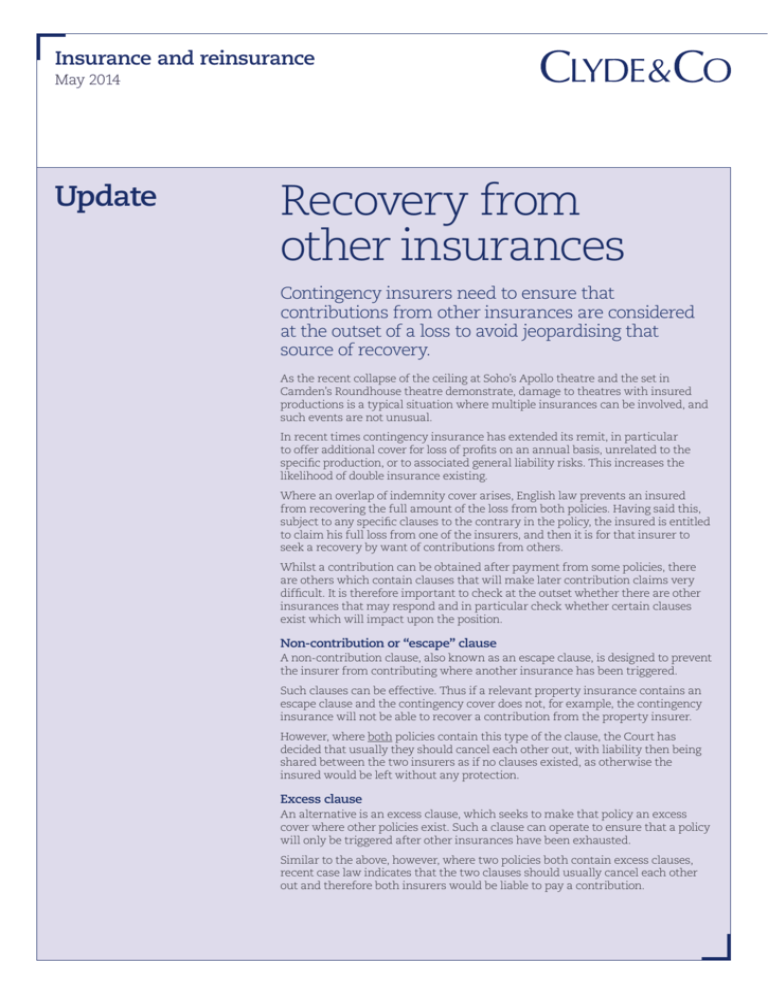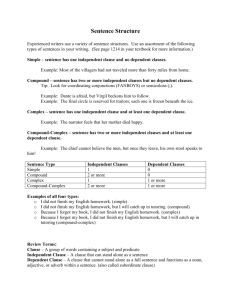Contingency Insurance - Recovery from other insurances
advertisement

Insurance and reinsurance May 2014 Update Recovery from other insurances Contingency insurers need to ensure that contributions from other insurances are considered at the outset of a loss to avoid jeopardising that source of recovery. As the recent collapse of the ceiling at Soho’s Apollo theatre and the set in Camden’s Roundhouse theatre demonstrate, damage to theatres with insured productions is a typical situation where multiple insurances can be involved, and such events are not unusual. In recent times contingency insurance has extended its remit, in particular to offer additional cover for loss of profits on an annual basis, unrelated to the specific production, or to associated general liability risks. This increases the likelihood of double insurance existing. Where an overlap of indemnity cover arises, English law prevents an insured from recovering the full amount of the loss from both policies. Having said this, subject to any specific clauses to the contrary in the policy, the insured is entitled to claim his full loss from one of the insurers, and then it is for that insurer to seek a recovery by want of contributions from others. Whilst a contribution can be obtained after payment from some policies, there are others which contain clauses that will make later contribution claims very difficult. It is therefore important to check at the outset whether there are other insurances that may respond and in particular check whether certain clauses exist which will impact upon the position. Non-contribution or “escape” clause A non-contribution clause, also known as an escape clause, is designed to prevent the insurer from contributing where another insurance has been triggered. Such clauses can be effective. Thus if a relevant property insurance contains an escape clause and the contingency cover does not, for example, the contingency insurance will not be able to recover a contribution from the property insurer. However, where both policies contain this type of the clause, the Court has decided that usually they should cancel each other out, with liability then being shared between the two insurers as if no clauses existed, as otherwise the insured would be left without any protection. Excess clause An alternative is an excess clause, which seeks to make that policy an excess cover where other policies exist. Such a clause can operate to ensure that a policy will only be triggered after other insurances have been exhausted. Similar to the above, however, where two policies both contain excess clauses, recent case law indicates that the two clauses should usually cancel each other out and therefore both insurers would be liable to pay a contribution. Rateable proportion clause A further variation is the rateable proportion clause which provides that, where other insurances exist, the insurer shall only bear its own rateable proportion of the loss. In practice this means that each policy pays a percentage apportionment of the loss by reference to the policy limits of each insurance. Arguments can develop where a tower of cover is provided to the insured with a series of policies in layers as to whether only the primary layer should be included in such calculations. There are also issues as to whether the two policies are entirely co-extensive. A rateable proportion clause operates whether it appears only in one policy or in all policies responding to the loss. Therefore, to obtain full indemnity the insured will have to claim from each insurer its rateable proportion of the loss. There is a risk that if an insurer pays more than its proportion to the insured, it may have paid as a “volunteer” and be barred from recovering a contribution. Practical solutions are available to allow an insured to be indemnified before agreement between contributing insurers, such as a carefully drafted waiver. Battle of the clauses Where different clauses exist in different policies, the position can be very complex, particularly if the policies have different governing laws. The interaction between rateable proportion clauses and excess clauses or escape clauses, for example, is a matter of contention, with different jurisdictions adopting very different approaches. In the recent case of National Farmers Union Mutual Insurance Society Ltd v HSBC Insurance (UK) Ltd [2010] the Court reviewed the long history of cases addressing the three categories of the above clause and their inter-relation. Further information If you would like further information on any issue raised in this update please contact: Michelle Crorie E: michelle.crorie@clydeco.com Clyde & Co LLP The St Botolph Building 138 Houndsditch London EC3A 7AR T: +44 (0)20 7876 5000 F: +44 (0)20 7876 5111 Further advice should be taken before relying on the contents of this summary. Clyde & Co LLP accepts no responsibility for loss occasioned to any person acting or refraining from acting as a result of material contained in this summary. No part of this summary may be used, reproduced, stored in a retrieval system or transmitted in any form or by any means, electronic, mechanical, photocopying, reading or otherwise without the prior permission of Clyde & Co LLP. Clyde & Co LLP is a limited liability partnership registered in England and Wales. Authorised and regulated by the Solicitors Regulation Authority. © Clyde & Co LLP 2014 CC005158 - May 2014 Ultimately the Court found that the two policies in issue did not overlap and consequently it was not necessary to determine conclusively the interaction of the “rateable proportion” clause in the NFU policy and the “excess” provision in the HSBC policy. However, the Court referenced two different possible approaches where two such clauses appear: historical case precedents in English law which pointed towards requiring both policies to respond to a “rateable proportion”; and US, Australian and New Zealand authorities which tended towards the “excess” clause operating to absolve that insurer of any liability, with the “rateable proportion” insurer meeting the whole loss. In summary it is clear that a policy without any clause relating to “other insurance” will be at a considerable disadvantage when seeking a contribution from other insurers. In addition, before any claims settlement the position should be considered and protected by insurers to avoid losing contribution rights.








